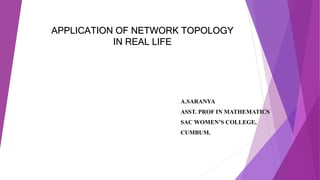
TOPOLOGY
- 1. APPLICATION OF NETWORK TOPOLOGY IN REAL LIFE A.SARANYA ASST. PROF IN MATHEMATICS SAC WOMEN’S COLLEGE, CUMBUM.
- 2. ABSTRACT Network topologies define the layout, virtual shape or structure of network, not only physically but also logically. The way in which different systems and nodes are connected and communicate with each other is determined by topology of the network. The geometrical arrangement of computer resources, remote devices and communication facilities is known as Network structure or Network topology. A link is a communication path between two nodes. The terms “circuit” and “Channel” are frequently used as synonyms for the link. There are different types of the topologies like bus, ring, tree, mesh etc. However, we will consider five basic network structures- topology.
- 3. INTRODUCTION : Among these are certain questions in geometry investigated by Leonhard Euler. His 1736 paper on the Seven Bridges of Königsberg is regarded as one of the first practical applications of topology. On 14 November 1750, Euler wrote to a friend that he had realised the importance of the edges of a polyhedron. Topology is the mathematical study of the properties that are preserved through deformations, twistings, and stretchings of object. Network topology refers to the physical or logical layout of a network. It defines the way different nodes are placed and interconnected with each other. Alternately, network topology may describe how the data is transferred between these nodes. There are two types of network topologies: physical and logical. A circle is topologically equivalent to an ellipse (into which it can be deformed by stretching) and a sphere is equivalent to an ellipsoid. Basic elements of a computer network include hardware, software, and protocols. The interrelationship of these basic elements constitutes the infrastructure of the network. A network infrastructure is the topology in which the nodes of a local area network (LAN) or a wide area network (WAN) are connected to each other.A computer network is a set of computers connected together for the purpose of sharing resources. The most common resource shared today is connection to the Internet. Other shared resources can include a printer or a file server. The Internet itself can be considered a computer network.
- 4. KEYWORDS: Physical Network Topology, Logical Network Topology, Minimum Spanning Tree, Graph Theory, Bus Network Topology, Ring Network Topology, Star Network Topology, Tree Network Topology, Mesh Network Topology, Hybrid Topology. Directed Graph, Undirected Graph, Queuing Theory, Combinatorial Trials, Tree-Bus Topology. TOPOLOGY STUDY USED IN REAL LIFE : Use a Topology study to explore design iterations of a component that satisfy a given optimization goal and geometric constraints. ... With a Topology study, you can set a design goal to find the best stiffness to weight ratio, minimize the mass, or reduce the maximum displacement of a component. Topology is used in many branches of mathematics, such as differentiable equations, dynamical systems, knot theory, and Riemann surfaces in complex analysis. It is also used in string theory in physics, and for describing the space-time structure of universe.
- 5. Following are these connection types available: Dial-up Connection. ISDN. DSL. Cable TV Internet connections. Satellite Internet connections. Wireless Internet Connections.
- 6. TYPES OF NETWORK TOPOLOGY
- 7. MESH TOPOLOGY: In mesh topology, every device is connected to another device via particular channel. STAR TOPOLOGY : In star topology, all the devices are connected to a single hub through a cable. This hub is the central node and all others nodes are connected to the central node. The hub can be passive in nature i.e. not intelligent hub such as broadcasting devices, at the same time the hub can be intelligent known as active hubs. Active hubs have repeaters in them. BUS TOPOLOGY : Bus topology is a network type in which every computer and network device is connected to single cable. It transmits the data from one end to another in single direction. No bi-directional feature is in bus topology. RING TOPOLOGY: In this topology, it forms a ring connecting a devices with its exactly two neighbouring devices.
- 9. Types of Networks Explained: VPN, LAN & More Personal Area Network (PAN) ... Local Area Network (LAN) ... Wireless Local Area Network (WLAN) ... Campus Area Network (CAN) ... Metropolitan Area Network (MAN) ... Wide Area Network (WAN) ... Storage-Area Network (SAN) ... System-Area Network (also known as SAN)
- 12. LAN Different from WAN: A LAN (local area network) is a group of computers and network devices connected together, usually within the same building. ... A WAN connects several LANs, and may be limited to an enterprise (a corporation or an organization) or accessible to the public. The technology is high speed and relatively expensive. A LAN might include thousands of computers or just a few, but all LANs are made up from the same basic handful of components. Components of a LAN. ... Network Workstations. ... Network Interface Cards and Drivers. ... Shared Hardware Resources. ... Networking Operating System (OS) ... Network-Aware Programs. ... A Communications Medium.
- 13. Network Topology refers to layout of a network. How different nodes in a network are connected to each other and how they communicate is determined by the network's topology. Computer Network Topology brings inherent advantages and disadvantages to any system under study. Description of some of these advantages and disadvantages for several standard physical topologies has been provided in this paper. OR performance analysis studies do not solely focus on physical topology, but logical topology as well. Graph Theory provides a useful tool in prosecuting these analysis. This paper has provided several examples of analysis approaches for dealing with topologically related problems. Those areas covered included routing analysis, network sizing, and network corruption. The techniques covered in this discussion can be adapted to related computer network applications. Understanding of Computer Network Topology is fundamental to any network analysis effort, and may prevent wasted effort in the pursuit of less productive analysis approaches. CONCLUSION